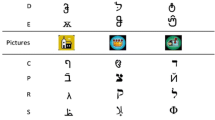Abstract
Equivalence formation, expansion, and reversal were investigated as a result of arbitrary matching associated with specific reinforcers. Four 4- and 5-year-old normal children were taught identity matching with stimuli, A, B, C, and D, and stimulus-specific reinforcement. Then the children were taught two conditional discriminations AB and BC. All subjects showed formation of the ABC stimulus classes; one subject, however, did not show expansion to ABCD classes. This subject was taught to name the D stimuli, he then demonstrated the expanded class. Next, 2 subjects who showed expanded classes were taught identity matching with the reinforcers reversed for the D stimuli. In tests that followed, their matching responses remained consistent with the original equivalence classes. These subjects were then taught to reverse the names for the D stimuli. As a result, the children reversed the classes. The results suggest that class expansion and subsequent reformation of classes may be facilitated when stimulus within each class controls a common naming response.
Similar content being viewed by others
References
DEVANY, J. M., HAYES, S. C., & NELSON, R. O. (1986). Equivalence class formation in language-able and language disabled children. Journal of the Experimental Analysis of Behavior, 46, 243–257.
DUBE, W. V., McILVANE, W. J., MAGUIRE, R. W., MACKAY, H. A., & STODDARD, L. T. (1989). Stimulus class formation and stimulus-reinforcer relations. Journal of the Experimental Analysis of Behavior, 51, 65–76.
DUGDALE, N., & LOWE, C. F. (1990). Naming and stimulus equivalence. In D. E. Blackman & H. Lejeune (Eds.), Behaviour analysis in theory and practice: Contributions and controversies (pp. 115–138). Brighton, U.K.: Erlbaum.
EIKESETH, S., & SMITH, T. (1992). The development of functional and equivalence classes in high functioning autistic children: The role of naming. Journal of the Experimental Analysis of Behavior, 58, 123–133.
HAYES, L. J., TILLEY, K. J., & HAYES, S. C. (1988). Extending equivalence class membership to gustatory stimuli. The Psychological Record, 38, 473–482.
McINTIRE, K. D., CLEARY, J., & THOMPSON, T. (1987). Conditional relations by monkeys: reflexivity, symmetry, and transitivity. Journal of the Experimental Analysis of Behavior, 47, 279–285.
PILGRIM, C., CHAMBERS, L., & GAUZIO, M. (1995). Reversal of baseline relations and stimulus equivalence: II. Children. Journal of the Experimental Analysis of Behavior, 63(3), 239–254.
PILGRIM, C., & GALIZIO, M. (1990). Relations between baseline contingencies and equivalence probe performances. Journal of the Experimental Analysis of Behavior, 54, 213–224.
PILGRIM, C., & GALIZIO, M. (1995). Reversal of baseline relations and stimulus equivalence I: Adults. Journal of the Experimental Analysis of Behavior, 63, 225–238.
SAUNDERS, K. J., & SPRADLIN, J. E. (1989). Conditional discrimination in mentally retarded adults: The effect of training the component simple discriminations. Journal of the Experimental Analysis of Behavior, 52, 1–12.
SAUNDERS, R. R., DRAKE, K. M., & SPRADLIN, J. E. (1999). Equivalence class establishment, expansion, and modification in preschool children. Journal of the Experimental Analysis of Behavior, 71, 195–214.
SAUNDERS, R. R., SAUNDERS, K. J., KIRBY, K. C., & SPRADLIN, J. E. (1988). The merger and development of equivalence classes by unreinforced conditional selection of comparison stimuli. Journal of the Experimental Analysis of Behavior, 50(2), 145–162.
SCHENK, J. J. (1994). Emergent relations of equivalence generated by outcome-specific consequences in conditional discrimination. The Psychological Record, 44, 537–558.
SIDMAN, M. (1990). Equivalence relations: Where do they come from? In D. E. Blackman & H. Lejeune (Eds.), Behaviour analysis in theory and practice: Contributions and controversies. Brighton, U.K.: Erlbaum.
SIDMAN, M., KIRK, B., & WILLSON-MORRIS, M. (1985). Six-member stimulus classes generated by conditional-discrimination procedures. Journal of the Experimental Analysis of Behavior, 43, 21–42.
SIDMAN, M., & TAILBY, W. (1982). Conditional discrimination vs. matching to sample: An expansion of the testing paradigm. Journal of the Experimental Analysis of Behavior, 37(1), 5–22.
Author information
Authors and Affiliations
Corresponding author
Additional information
The experiments were made possible by post-doctoral scholarships from the Kronenhalle Foundation (Luxemburg) and CNPq (Brazil). Manuscript preparation was supported by FAPESP Grant 98/1730-0
The work described here would not have been possible without the contributions from Fergus Lowe and the University College of North Wales, Bangor; Mr. Roberts, headmaster; and Mrs. Reagan, classroom teacher, of Ysgol Y Faenol. A very special ‘thank you’ goes to the children who participated and their parents. I am greatly indebted to Joe Spradlin, for his competent editorial work and conceptual contributions to this paper. I am also grateful to Bill Dube for his careful reading and critical comments on earlier versions of the manuscript, and to Rita Spradlin and Pat White for proofreading it
Rights and permissions
About this article
Cite this article
Goyos, C. Equivalence Class Formation Via Common Reinforcers Among Preschool Children. Psychol Rec 50, 629–654 (2000). https://doi.org/10.1007/BF03395375
Published:
Issue Date:
DOI: https://doi.org/10.1007/BF03395375




